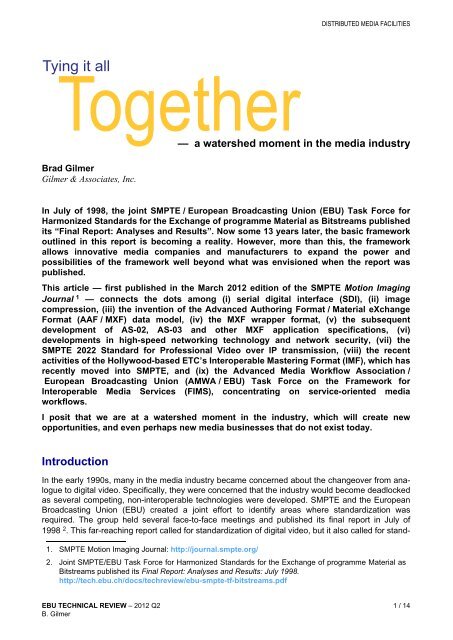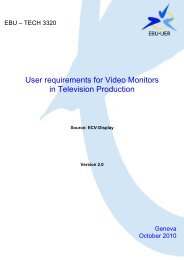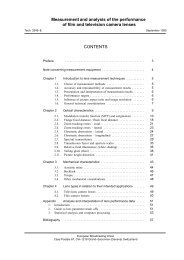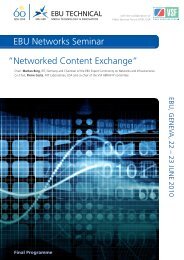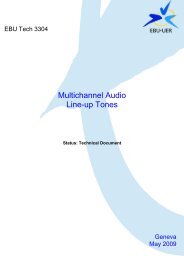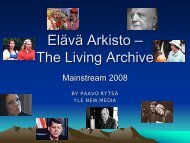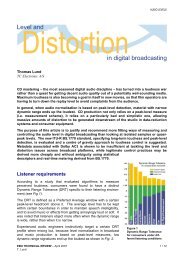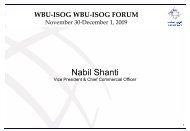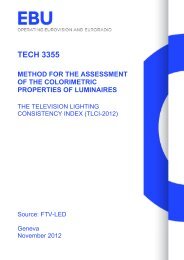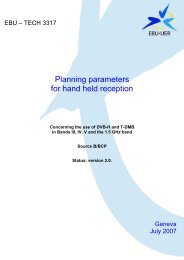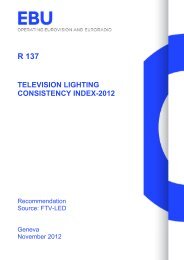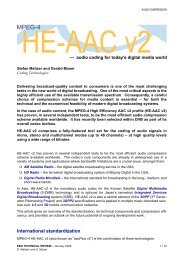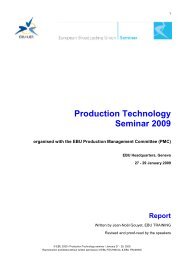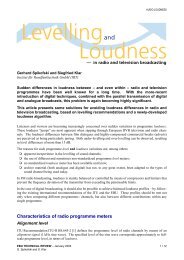Tying it all together - a watershed moment in the media industry
Tying it all together - a watershed moment in the media industry
Tying it all together - a watershed moment in the media industry
You also want an ePaper? Increase the reach of your titles
YUMPU automatically turns print PDFs into web optimized ePapers that Google loves.
Brad Gilmer<br />
Gilmer & Associates, Inc.<br />
DISTRIBUTED MEDIA FACILITIES<br />
<strong>Ty<strong>in</strong>g</strong> <strong>it</strong> <strong>all</strong><br />
Toge<strong>the</strong>r<br />
— a <strong>watershed</strong> <strong>moment</strong> <strong>in</strong> <strong>the</strong> <strong>media</strong> <strong>in</strong>dustry<br />
In July of 1998, <strong>the</strong> jo<strong>in</strong>t SMPTE / European Broadcast<strong>in</strong>g Union (EBU) Task Force for<br />
Harmonized Standards for <strong>the</strong> Exchange of programme Material as B<strong>it</strong>streams published<br />
<strong>it</strong>s “F<strong>in</strong>al Report: Analyses and Results”. Now some 13 years later, <strong>the</strong> basic framework<br />
outl<strong>in</strong>ed <strong>in</strong> this report is becom<strong>in</strong>g a real<strong>it</strong>y. However, more than this, <strong>the</strong> framework<br />
<strong>all</strong>ows <strong>in</strong>novative <strong>media</strong> companies and manufacturers to expand <strong>the</strong> power and<br />
possibil<strong>it</strong>ies of <strong>the</strong> framework well beyond what was envisioned when <strong>the</strong> report was<br />
published.<br />
This article — first published <strong>in</strong> <strong>the</strong> March 2012 ed<strong>it</strong>ion of <strong>the</strong> SMPTE Motion Imag<strong>in</strong>g<br />
Journal 1 — connects <strong>the</strong> dots among (i) serial dig<strong>it</strong>al <strong>in</strong>terface (SDI), (ii) image<br />
compression, (iii) <strong>the</strong> <strong>in</strong>vention of <strong>the</strong> Advanced Author<strong>in</strong>g Format / Material eXchange<br />
Format (AAF / MXF) data model, (iv) <strong>the</strong> MXF wrapper format, (v) <strong>the</strong> subsequent<br />
development of AS-02, AS-03 and o<strong>the</strong>r MXF application specifications, (vi)<br />
developments <strong>in</strong> high-speed network<strong>in</strong>g technology and network secur<strong>it</strong>y, (vii) <strong>the</strong><br />
SMPTE 2022 Standard for Professional Video over IP transmission, (viii) <strong>the</strong> recent<br />
activ<strong>it</strong>ies of <strong>the</strong> Hollywood-based ETC’s Interoperable Master<strong>in</strong>g Format (IMF), which has<br />
recently moved <strong>in</strong>to SMPTE, and (ix) <strong>the</strong> Advanced Media Workflow Association /<br />
European Broadcast<strong>in</strong>g Union (AMWA / EBU) Task Force on <strong>the</strong> Framework for<br />
Interoperable Media Services (FIMS), concentrat<strong>in</strong>g on service-oriented <strong>media</strong><br />
workflows.<br />
I pos<strong>it</strong> that we are at a <strong>watershed</strong> <strong>moment</strong> <strong>in</strong> <strong>the</strong> <strong>in</strong>dustry, which will create new<br />
opportun<strong>it</strong>ies, and even perhaps new <strong>media</strong> bus<strong>in</strong>esses that do not exist today.<br />
Introduction<br />
In <strong>the</strong> early 1990s, many <strong>in</strong> <strong>the</strong> <strong>media</strong> <strong>in</strong>dustry became concerned about <strong>the</strong> changeover from analogue<br />
to dig<strong>it</strong>al video. Specific<strong>all</strong>y, <strong>the</strong>y were concerned that <strong>the</strong> <strong>in</strong>dustry would become deadlocked<br />
as several compet<strong>in</strong>g, non-<strong>in</strong>teroperable technologies were developed. SMPTE and <strong>the</strong> European<br />
Broadcast<strong>in</strong>g Union (EBU) created a jo<strong>in</strong>t effort to identify areas where standardization was<br />
required. The group held several face-to-face meet<strong>in</strong>gs and published <strong>it</strong>s f<strong>in</strong>al report <strong>in</strong> July of<br />
1998 2 . This far-reach<strong>in</strong>g report c<strong>all</strong>ed for standardization of dig<strong>it</strong>al video, but <strong>it</strong> also c<strong>all</strong>ed for stand-<br />
1. SMPTE Motion Imag<strong>in</strong>g Journal: http://journal.smpte.org/<br />
2. Jo<strong>in</strong>t SMPTE/EBU Task Force for Harmonized Standards for <strong>the</strong> Exchange of programme Material as<br />
B<strong>it</strong>streams published <strong>it</strong>s F<strong>in</strong>al Report: Analyses and Results: July 1998.<br />
http://tech.ebu.ch/docs/techreview/ebu-smpte-tf-b<strong>it</strong>streams.pdf<br />
EBU TECHNICAL REVIEW – 2012 Q2 1 / 14<br />
B. Gilmer
DISTRIBUTED MEDIA FACILITIES<br />
ards <strong>in</strong> a number of o<strong>the</strong>r areas, <strong>in</strong>clud<strong>in</strong>g standards for <strong>the</strong> exchange of content and metadata <strong>in</strong> a<br />
simple wrapper (now MXF), and <strong>in</strong> a more full-featured wrapper for ed<strong>it</strong> <strong>in</strong>terchange (now AAF). Fur<strong>the</strong>rmore,<br />
<strong>it</strong> explored standardization at <strong>the</strong> system layer, <strong>all</strong>ow<strong>in</strong>g <strong>in</strong>teroperable control arch<strong>it</strong>ectures.<br />
In <strong>the</strong> years s<strong>in</strong>ce <strong>the</strong> Task Force report was published, SMPTE has engaged <strong>in</strong> many efforts<br />
directly related to <strong>the</strong> report. Trade associations such as <strong>the</strong> Video Services Forum (VSF) 3 and <strong>the</strong><br />
Advanced Media Workflow Association (AMWA) 4 have served as <strong>in</strong>cubators and discussion groups<br />
for <strong>the</strong> development of <strong>in</strong>put documents to SMPTE.<br />
Key enabl<strong>in</strong>g technologies<br />
Clearly, development of <strong>the</strong> serial dig<strong>it</strong>al <strong>in</strong>terface (SDI) for video has been a key enabl<strong>in</strong>g technology<br />
because, w<strong>it</strong>hout <strong>it</strong>, <strong>the</strong> move from analogue to dig<strong>it</strong>al video would have been delayed for<br />
months, perhaps years. From where we s<strong>it</strong> now, <strong>it</strong> is hard to know how long <strong>it</strong> would have taken for a<br />
dom<strong>in</strong>ant technology to appear, and how many millions of dollars would have been spent on equipment<br />
that would have soon become obsolete.<br />
Taken <strong>toge<strong>the</strong>r</strong>, <strong>the</strong> collective improvements <strong>in</strong> computer process<strong>in</strong>g power, reduction <strong>in</strong> <strong>the</strong> cost of<br />
storage, <strong>the</strong> <strong>in</strong>crease <strong>in</strong> <strong>the</strong> dens<strong>it</strong>y of storage, <strong>the</strong> <strong>in</strong>crease <strong>in</strong> network<strong>in</strong>g speeds, and <strong>the</strong> ubiqu<strong>it</strong>y<br />
of <strong>in</strong>ternet protocol (IP) should be considered key enabl<strong>in</strong>g technologies for <strong>the</strong> <strong>media</strong> <strong>in</strong>dustry. The<br />
recent focus by mass-market computer software and hardware vendors on consumer video as <strong>the</strong><br />
“next big th<strong>in</strong>g” has driven down costs and driven up <strong>the</strong> capabil<strong>it</strong>ies of generic computer platforms<br />
<strong>in</strong> a way that <strong>the</strong> professional <strong>media</strong> <strong>in</strong>dustry never could have done. The ramifications of <strong>the</strong>se key<br />
enabl<strong>in</strong>g technologies have yet to be fully recognized.<br />
What problem are we try<strong>in</strong>g to solve?<br />
The question “What problem are we try<strong>in</strong>g to solve?” is a frequent refra<strong>in</strong> at SMPTE technology<br />
comm<strong>it</strong>tee meet<strong>in</strong>gs. So, <strong>in</strong> pull<strong>in</strong>g a number of disparate threads <strong>toge<strong>the</strong>r</strong>, perhaps <strong>it</strong> would be best<br />
to start w<strong>it</strong>h a description of <strong>the</strong> problem.<br />
Media decompos<strong>it</strong>ion<br />
In <strong>the</strong> beg<strong>in</strong>n<strong>in</strong>g, <strong>the</strong>re was film — and film was easy 5 . You had a sequence of pictures captured on<br />
<strong>the</strong> film, and you had sound. You may have had to deal w<strong>it</strong>h whe<strong>the</strong>r <strong>the</strong> sound was mag stripe or<br />
optical, but o<strong>the</strong>r than that, film was pretty much plug-and-play (load and play, actu<strong>all</strong>y). Film came<br />
<strong>in</strong> a metal can, and affixed to <strong>the</strong> can and <strong>the</strong> film reel, <strong>the</strong>re was a paper label that told you pretty<br />
much everyth<strong>in</strong>g you needed to know. All a projectionist at a <strong>the</strong>atre or a telec<strong>in</strong>e operator at a television<br />
station had to do was verify that <strong>the</strong> <strong>in</strong>formation on <strong>the</strong> label matched <strong>the</strong> movie to be played,<br />
load <strong>the</strong> film, and put <strong>the</strong> projector <strong>in</strong> remote so that <strong>it</strong> could be started at <strong>the</strong> appropriate time.<br />
3. For more <strong>in</strong>formation on <strong>the</strong> Video Services Forum see http://www.videoservicesforum.org/.<br />
4. For more <strong>in</strong>formation on <strong>the</strong> Advanced Media Workflow Association see http://www.amwa.tv/.<br />
5. Film was actu<strong>all</strong>y very hard! One of <strong>the</strong> first tasks <strong>the</strong> SMPE (<strong>the</strong> Society of Motion Picture Eng<strong>in</strong>eers, a<br />
precursor to <strong>the</strong> current SMPTE) took on was <strong>the</strong> standardization of film. W<strong>it</strong>hout this effort, film technology<br />
would have w<strong>all</strong>owed for many years. For an excellent description of <strong>the</strong>se early standardization efforts,<br />
see Technological History of Motion Pictures and Television: An Anthology from <strong>the</strong> Pages of <strong>the</strong><br />
“Journal of <strong>the</strong> Society of Motion Picture and Television Eng<strong>in</strong>eers” by Raymond Field<strong>in</strong>g (hardcover,<br />
Jan. 31, 1980).<br />
EBU TECHNICAL REVIEW – 2012 Q2 2 / 14<br />
B. Gilmer
DISTRIBUTED MEDIA FACILITIES<br />
Along came videotape — and videotape was easy 6 . As w<strong>it</strong>h film, you had a tape <strong>in</strong> a box. The box<br />
and <strong>the</strong> tape both had a label, and <strong>the</strong>re was usu<strong>all</strong>y a piece of paper <strong>in</strong> <strong>the</strong> box. Once aga<strong>in</strong>, <strong>all</strong> an<br />
operator had to do was to verify <strong>the</strong> label w<strong>it</strong>h <strong>the</strong> <strong>in</strong>formation on <strong>the</strong> log, load <strong>the</strong> tape mach<strong>in</strong>e, and<br />
put <strong>the</strong> mach<strong>in</strong>e <strong>in</strong> remote so that <strong>it</strong> could be started at <strong>the</strong> appropriate time.<br />
Then along came <strong>media</strong> files — <strong>the</strong>y were not qu<strong>it</strong>e as easy. The difficulties pretty much started and<br />
ended w<strong>it</strong>h <strong>the</strong> codecs used to create <strong>the</strong> files. Early on, just about any video file available was compressed,<br />
if for no o<strong>the</strong>r reason than that <strong>the</strong> sheer size of uncompressed files overwhelmed just<br />
about every aspect of computer technology. Because codecs are software (even when <strong>in</strong>stantiated<br />
<strong>in</strong> hardware), and because even early compression methods <strong>all</strong>owed a very large number of choices<br />
to be made <strong>in</strong> cod<strong>in</strong>g <strong>the</strong> material, <strong>in</strong>teroperabil<strong>it</strong>y issues were rampant. Along w<strong>it</strong>h <strong>all</strong> <strong>the</strong> codec<br />
<strong>in</strong>teroperabil<strong>it</strong>y issues, <strong>the</strong>re was also a huge knowledge gap. People who had worked w<strong>it</strong>h video <strong>all</strong><br />
<strong>the</strong>ir lives suddenly found <strong>the</strong>mselves confronted w<strong>it</strong>h a myriad of configuration parameters for cod<strong>in</strong>g<br />
and decod<strong>in</strong>g, and misconfiguration was <strong>the</strong> order of <strong>the</strong> day. Of course, even if you were able to<br />
properly decompress a file, noth<strong>in</strong>g would help you if you were try<strong>in</strong>g to play back video on a system<br />
that could not understand <strong>the</strong> orig<strong>in</strong>al dig<strong>it</strong>al video format.<br />
Along w<strong>it</strong>h files came some new term<strong>in</strong>ology. We were no longer deal<strong>in</strong>g w<strong>it</strong>h a cassette or a reel of<br />
film. In fact, <strong>the</strong>re was a separation of <strong>the</strong> physical <strong>media</strong> from <strong>the</strong> content <strong>it</strong> conta<strong>in</strong>ed. The essence<br />
on <strong>the</strong> tape became an Asset: Content, Essence, or <strong>in</strong> some circles, Media. Metadata became a<br />
popular topic. We started hear<strong>in</strong>g about data models. These were new concepts and <strong>the</strong>y took some<br />
gett<strong>in</strong>g used to.<br />
Fortunately over time, th<strong>in</strong>gs have got much better. For <strong>the</strong> most part, video eng<strong>in</strong>eers now understand<br />
how to configure codecs to get reliable results. Most people know that you must have a dest<strong>in</strong>ation<br />
device that understands <strong>the</strong> source video format if you want to get pictures at <strong>the</strong> far end,<br />
and, for <strong>the</strong> most part, manufacturers have done a good job of provid<strong>in</strong>g <strong>in</strong>teroperabil<strong>it</strong>y modes on<br />
<strong>the</strong>ir codecs that reduce <strong>in</strong>compatibil<strong>it</strong>ies. So, while <strong>the</strong> term<strong>in</strong>ology is still new to many of us, we are<br />
gett<strong>in</strong>g more comfortable w<strong>it</strong>h <strong>the</strong> new vocabulary that files brought w<strong>it</strong>h <strong>the</strong>m.<br />
The first <strong>in</strong>dication that difficult problems could occur, came w<strong>it</strong>h dig<strong>it</strong>al versatile discs (DVDs). The<br />
good news was that codec <strong>in</strong>teroperabil<strong>it</strong>y was good because <strong>the</strong> DVD specification constra<strong>in</strong>ed <strong>the</strong><br />
codec options. The bad news was that <strong>the</strong> DVD conta<strong>in</strong>ed more than one video and audio comb<strong>in</strong>ation.<br />
For example, a DVD might conta<strong>in</strong> a video track and <strong>the</strong> English version audio track. It might<br />
also conta<strong>in</strong> a French language audio track. Fur<strong>the</strong>rmore, <strong>it</strong> might conta<strong>in</strong> Portuguese subt<strong>it</strong>les, a<br />
director’s commentary audio track, outtakes from <strong>the</strong> movie, photographs of orig<strong>in</strong>al movie sets or<br />
artefacts, and so on. The DVD specification 7 <strong>in</strong>cludes <strong>in</strong>structions for how to lay out <strong>the</strong>se add<strong>it</strong>ional<br />
components on disk and how to pull <strong>the</strong>m <strong>toge<strong>the</strong>r</strong> for presentation to <strong>the</strong> viewer. Put simplistic<strong>all</strong>y,<br />
<strong>the</strong> DVD wrapper is standardized.<br />
Many versions, many elements<br />
A s<strong>in</strong>gle DVD conta<strong>in</strong>s many <strong>in</strong>dividual elements. The DVD also conta<strong>in</strong>s <strong>in</strong>structions on how to<br />
comb<strong>in</strong>e <strong>the</strong>se elements to render a particular version of a movie to <strong>the</strong> viewer. The DVD highlighted<br />
a problem that <strong>the</strong> Hollywood commun<strong>it</strong>y had been struggl<strong>in</strong>g w<strong>it</strong>h for some time.<br />
Humans tend to th<strong>in</strong>k of a movie as one particular th<strong>in</strong>g. Take Avatar, for example. Most people <strong>in</strong><br />
<strong>the</strong> <strong>in</strong>dustry have seen this movie, but <strong>it</strong> turns out that <strong>the</strong>re are more than 120 different versions of<br />
Avatar, and <strong>the</strong>se 120 versions are composed of hundreds, if not thousands of elements — video<br />
6. Videotape was actu<strong>all</strong>y a l<strong>it</strong>tle tricky too. Of course you had <strong>the</strong> different video standards, NTSC (National<br />
Television System Comm<strong>it</strong>tee), PAL (Phase Alternat<strong>in</strong>g L<strong>in</strong>e), and SECAM (Séquentiel couleur à mémoire),<br />
and you also had some <strong>in</strong>compatibil<strong>it</strong>y issues w<strong>it</strong>h<strong>in</strong> a format (Sony vs. Ampex 1”, for example).<br />
However, by and large, video tape was comparatively straightforward.<br />
7. DVD specifications are ma<strong>in</strong>ta<strong>in</strong>ed by <strong>the</strong> DVD Forum (http://www.dvdforum.org/) as “books” such as<br />
<strong>the</strong> DVD-Rom Book, DVD-Audio Book, etc.<br />
EBU TECHNICAL REVIEW – 2012 Q2 3 / 14<br />
B. Gilmer
DISTRIBUTED MEDIA FACILITIES<br />
tracks, audio tracks, subt<strong>it</strong>le streams, natural sound tracks, computer-generated imagery (CGI) elements<br />
and so on. Studios are faced w<strong>it</strong>h <strong>the</strong> daunt<strong>in</strong>g task of keep<strong>in</strong>g track of a grow<strong>in</strong>g number of<br />
elements as <strong>the</strong> number of target platforms, such as mobile devices, desktops and tablets cont<strong>in</strong>ues<br />
to grow. Keep<strong>in</strong>g track of <strong>the</strong>se elements, and keep<strong>in</strong>g <strong>the</strong>m properly associated, is a serious problem.<br />
The Interoperable Master<strong>in</strong>g Format<br />
Hollywood responded to <strong>the</strong> problem by form<strong>in</strong>g a group under <strong>the</strong> Enterta<strong>in</strong>ment Technology<br />
Center (ETC) 8 . The ETC began work<strong>in</strong>g on <strong>the</strong> Interoperable Master<strong>in</strong>g Format (IMF). At <strong>it</strong>s heart<br />
was <strong>the</strong> concept of us<strong>in</strong>g a common wrapper to organize <strong>all</strong> <strong>the</strong> elements that comprise <strong>the</strong> different<br />
versions of a movie, and to <strong>the</strong>n use technology to render a specific version of <strong>the</strong> movie on<br />
demand. Elements are collected <strong>in</strong>to bundles, and bundles are used to create versions.<br />
The ETC has concluded <strong>it</strong>s work and has produced an <strong>in</strong>put document that is currently under consideration<br />
w<strong>it</strong>h<strong>in</strong> <strong>the</strong> SMPTE 35PM50-IMF Work<strong>in</strong>g Group, chaired by Annie Chang, for development<br />
as a SMPTE standard.<br />
Figure 1<br />
A typical movie workflow and <strong>the</strong> Interoperable Master<strong>in</strong>g Format (Figure courtesy of <strong>the</strong> Walt Disney Studios)<br />
Fig. 1 shows that, <strong>in</strong> <strong>the</strong> IMF typical workflow use case, content is acquired via <strong>the</strong> film camera,<br />
microphones, etc. Through <strong>the</strong> Dig<strong>it</strong>al Inter<strong>media</strong>te process, <strong>the</strong> f<strong>in</strong>ished film or Dig<strong>it</strong>al C<strong>in</strong>ema<br />
Package is created. However, note that <strong>in</strong> add<strong>it</strong>ion to <strong>the</strong> rendered film and <strong>the</strong> DCP, an IMF wrapper<br />
bundles <strong>all</strong> <strong>the</strong> elements for <strong>the</strong> different versions <strong>toge<strong>the</strong>r</strong>. The bundle is <strong>the</strong>n used to create different<br />
versions of <strong>the</strong> movie on Blu-ray, DVD, for television, etc.<br />
MXF — <strong>the</strong> solution to everyth<strong>in</strong>g<br />
In 1998, <strong>the</strong> jo<strong>in</strong>t SMPTE-EBU Task Force for Harmonized Standards for <strong>the</strong> Exchange of programme<br />
Material as B<strong>it</strong>streams 1 report identified <strong>the</strong> need for a simple wrapper format. The Material<br />
eXchange Format has emerged as <strong>the</strong> simple standards-based wrapper 9 .<br />
8. Enterta<strong>in</strong>ment Technology Center: http://www.etcenter.org/.<br />
9. QuickTime is also frequently deployed <strong>in</strong> professional applications. The specification is owned by Apple<br />
(http://www.apple.com/quicktime/).<br />
EBU TECHNICAL REVIEW – 2012 Q2 4 / 14<br />
B. Gilmer
As Fig. 2 illustrates, <strong>the</strong> purpose of an MXF<br />
wrapper is to apply some rigour to <strong>the</strong> location<br />
and identification of various components of a<br />
f<strong>in</strong>ished programme. It also provides a common<br />
way of establish<strong>in</strong>g <strong>the</strong> tim<strong>in</strong>g relationship<br />
between different components of <strong>the</strong> f<strong>in</strong>ished<br />
programme, e.g., video/audio synchronization.<br />
Unfortunately, many problems that seem simple<br />
at first, become more complex as you get <strong>in</strong>to<br />
<strong>the</strong> details. Over time, <strong>the</strong> MXF specification 10<br />
became <strong>in</strong>creas<strong>in</strong>gly <strong>in</strong>volved as <strong>it</strong> expanded to<br />
accommodate a number of different scenarios.<br />
In <strong>the</strong> end, <strong>the</strong> specification grew to more than<br />
600 pages. As a result, <strong>in</strong>teroperabil<strong>it</strong>y issues<br />
surfaced as manufacturers implemented <strong>the</strong><br />
wr<strong>it</strong>ten document <strong>in</strong> different ways. While MXF<br />
ended up be<strong>in</strong>g very full-featured, manufacturers<br />
found <strong>it</strong> difficult to achieve reliable <strong>in</strong>terchange.<br />
Application specifications<br />
Application specifications (AS) have been created<br />
by <strong>the</strong> AMWA to <strong>in</strong>crease <strong>in</strong>teroperabil<strong>it</strong>y<br />
of MXF files <strong>in</strong> specific areas. An AS may<br />
require, for example, that although <strong>the</strong>re are<br />
five different places where you are <strong>all</strong>owed to<br />
DISTRIBUTED MEDIA FACILITIES<br />
put a time code <strong>in</strong> an MXF file, only put time code here. Application specifications may also put lim<strong>it</strong>ations<br />
on essence cod<strong>in</strong>g, for example, stat<strong>in</strong>g that only MPEG-2 coded at rates between 5 and 50<br />
Mb<strong>it</strong>/s w<strong>it</strong>h a group of pictures (GOP) of 15 are <strong>all</strong>owed. An AS may also state that <strong>the</strong> only acceptable<br />
reference to an external piece of content is a Universal Resource Identifier (URI) as specified by<br />
<strong>the</strong> W3C. So, as Fig. 3 shows, an AS may draw on a number of different standards, referenc<strong>in</strong>g only<br />
<strong>the</strong> relevant parts, and <strong>the</strong>n be very specific about how those parts are to be used.<br />
One o<strong>the</strong>r key concept beh<strong>in</strong>d AS is “no new <strong>in</strong>vention”. This simply means that, <strong>in</strong> creat<strong>in</strong>g application<br />
specifications, we try hard to use exist<strong>in</strong>g specifications ra<strong>the</strong>r than create new ones.<br />
AS-03 — MXF for F<strong>in</strong>ished Programmes<br />
Figure 2<br />
An MXF wrapper provides a standardized way to<br />
wrap <strong>toge<strong>the</strong>r</strong> different components of a f<strong>in</strong>ished<br />
programme (Figure courtesy of Amberf<strong>in</strong>)<br />
AS-03 was sponsored by Jerry Butler and <strong>the</strong> Public Broadcast<strong>in</strong>g Service (PBS). Butler’s user<br />
requirements were clear: Butler wanted to def<strong>in</strong>e an MXF wrapper conta<strong>in</strong><strong>in</strong>g a s<strong>in</strong>gle standard def<strong>in</strong><strong>it</strong>ion<br />
f<strong>in</strong>ished programme. Butler wanted to be able to wrap that programme <strong>in</strong> AS-03, have <strong>the</strong> file<br />
land on servers at PBS affiliate stations, and have servers at those locations reliably retrieve <strong>the</strong><br />
metadata and play <strong>the</strong> content. Butler and a dedicated group of vendors worked to scale down <strong>the</strong><br />
MXF specification and, importantly, to constra<strong>in</strong> <strong>the</strong> format of <strong>the</strong> video and audio <strong>all</strong>owed <strong>in</strong> <strong>the</strong> AS-<br />
03 file 11 .<br />
10. The core specification for MXF is SMPTE ST 377-1:2009: Material Exchange Format (MXF) File Format<br />
Specification, available from http://www.smpte.org/. Implementers may also f<strong>in</strong>d SMPTE EG41: MXF<br />
Eng<strong>in</strong>eer<strong>in</strong>g Guide useful.<br />
11. It is important to note that noth<strong>in</strong>g <strong>in</strong> <strong>the</strong> MXF specifications constra<strong>in</strong>s <strong>the</strong> format of <strong>the</strong> video and audio<br />
wrapped <strong>in</strong> <strong>the</strong> MXF file. Therefore, <strong>it</strong> is possible to be able to understand <strong>the</strong> content of <strong>the</strong> MXF wrapper<br />
but still be unable to view <strong>the</strong> essence due to video/audio codec <strong>in</strong>teroperabil<strong>it</strong>y issues.<br />
EBU TECHNICAL REVIEW – 2012 Q2 5 / 14<br />
B. Gilmer
AS-10 — MXF for Production<br />
DISTRIBUTED MEDIA FACILITIES<br />
Figure 3<br />
Application specifications draw from exist<strong>in</strong>g standards. They state what parts of <strong>the</strong> standards to use, and<br />
how to use <strong>the</strong>m.<br />
The production commun<strong>it</strong>y had a set of user requirements related to file-based production. These<br />
requirements were gener<strong>all</strong>y met by someth<strong>in</strong>g known <strong>in</strong> <strong>the</strong> <strong>in</strong>dustry as SMPTE RDD-9 12 . Unfortunately,<br />
RDD-9 was not specific enough to ensure reliable <strong>in</strong>terchange of essence and metadata. A<br />
number of users and manufacturers decided to create a new AMWA Specification which was sufficiently<br />
detailed to <strong>in</strong>crease <strong>in</strong>teroperabil<strong>it</strong>y <strong>in</strong> <strong>the</strong> MXF production doma<strong>in</strong>.<br />
AS-11 — MXF for Contribution<br />
Butler had a very specific set of user requirements. This <strong>all</strong>owed him to get results relatively quickly,<br />
but <strong>it</strong> meant that AS-03 was not necessarily go<strong>in</strong>g to meet every requirement for f<strong>in</strong>ished programm<strong>in</strong>g.<br />
In <strong>the</strong> UK, <strong>the</strong> Dig<strong>it</strong>al Production Partnership (DPP) 13 had a requirement to <strong>in</strong>crease <strong>in</strong>teroperabil<strong>it</strong>y<br />
for f<strong>in</strong>ished programm<strong>in</strong>g, but <strong>the</strong>ir user requirements were different. First of <strong>all</strong>, <strong>the</strong>y<br />
required data rates up to 100 Mb<strong>it</strong>/s. Also, <strong>the</strong>y needed a metadata set which would meet <strong>the</strong><br />
requirements of UK broadcasters. MXF for Contribution meets <strong>the</strong> requirements of this market.<br />
AS-12 — MXF for Commercials<br />
There has been a need for a common commercial file format for qu<strong>it</strong>e some time. Demand has been<br />
grow<strong>in</strong>g. One can imag<strong>in</strong>e that <strong>the</strong> only difference between an AS for f<strong>in</strong>ished programmes and an<br />
AS for commercials would be <strong>the</strong> add<strong>it</strong>ion of “dig<strong>it</strong>al slate” metadata. This is exactly what AS-12<br />
does — <strong>it</strong> expands <strong>the</strong> AS-03 specification to <strong>in</strong>clude metadata identifiers, which can be used to<br />
uniquely identify commercial content. AS-12 will work w<strong>it</strong>h any commercial identifier, but <strong>in</strong> <strong>the</strong> first<br />
<strong>in</strong>stance, <strong>it</strong> is designed to work w<strong>it</strong>h Ad-ID.<br />
12. SMPTE RDD 09-2009 MXF Interoperabil<strong>it</strong>y Specification of Sony MPEG Long GOP Products.<br />
13. DPP: http://www.dig<strong>it</strong>alproductionpartnership.co.uk.<br />
EBU TECHNICAL REVIEW – 2012 Q2 6 / 14<br />
B. Gilmer
DISTRIBUTED MEDIA FACILITIES<br />
At <strong>the</strong> time this article was wr<strong>it</strong>ten, AS-02, AS-03, AS-11 and AS-12 were completed AMWA Specifications<br />
available for free download at <strong>the</strong> AMWA webs<strong>it</strong>e 14 . AS-10 — MXF for Production is <strong>in</strong> <strong>it</strong>s<br />
f<strong>in</strong>al draft form. Table 1 summarizes some of <strong>the</strong> key features of several AMWA Application Specifications.<br />
Table 1<br />
Some common restricted MXF parameters per application specification (Table courtesy of Al Kovalick)<br />
Restricted feature AS-03 AS-10 AS-11 AS-12<br />
Application doma<strong>in</strong> Programme<br />
delivery<br />
The <strong>media</strong> factory and AS-02<br />
Production Contribution Advert<br />
delivery<br />
Video b<strong>it</strong>rate SD/HD 5-50 Mb<strong>it</strong>/s (depends on codec) HD@ 100 Mb<strong>it</strong>/s SD/HD 5-50 Mb<strong>it</strong>/s<br />
Codec format MPEG-2, H.264<br />
LGOP<br />
MPEG-2 MP@HL,<br />
MPEG-2 422P@HL<br />
MPEG-2 MP@H14<br />
LGOP<br />
AVC-Intra MPEG-2, H.264<br />
LGOP<br />
MXF pattern Op-1a Op-1a Op-1a Op-1a<br />
Audio channels Up to 16 2 to 8 Up to 64 Up to 16<br />
Metadata “slate”<br />
scheme<br />
DMS-AS-03<br />
(programme slate)<br />
TBD DMS-AS-11-UK/DPP<br />
(dig<strong>it</strong>al production<br />
project specific)<br />
Ad-ID based slate<br />
metadata<br />
Closed caption CEA 608/708 CEA 608/708 CEA 608/708 CEA 608/708<br />
Co<strong>in</strong>cident w<strong>it</strong>h development of <strong>the</strong> task force report, many <strong>media</strong> companies began to face <strong>the</strong><br />
ch<strong>all</strong>enge of provid<strong>in</strong>g content to any platform, anywhere, through any distribution medium. The old<br />
way of creat<strong>in</strong>g one stove-pipe workflow to serve one particular output (say a broadcast network<br />
stream) was under <strong>in</strong>creas<strong>in</strong>g pressure. While <strong>media</strong> companies had frequently distributed content<br />
to c<strong>in</strong>emas, broadcast networks and to o<strong>the</strong>r stations via syndication, <strong>it</strong> was <strong>in</strong> <strong>the</strong> early 1990s that<br />
we began to see <strong>the</strong> need to feed <strong>the</strong> web, mobile and o<strong>the</strong>r outlets. This was seen as an opportun<strong>it</strong>y<br />
to monetize content through “ano<strong>the</strong>r antenna”. Unfortunately, <strong>it</strong> was extremely ch<strong>all</strong>eng<strong>in</strong>g to<br />
build a new “channel” at a cost that would not s<strong>in</strong>k <strong>the</strong> nascent bus<strong>in</strong>ess opportun<strong>it</strong>y. At that time, <strong>it</strong><br />
took a certa<strong>in</strong> base level of <strong>in</strong>frastructure to create a 24-hour stream of programm<strong>in</strong>g, and although<br />
technical people are actu<strong>all</strong>y qu<strong>it</strong>e creative, costs could only be reduced to a certa<strong>in</strong> extent. At <strong>the</strong><br />
same time, demands for new streams of content cont<strong>in</strong>ued to <strong>in</strong>crease, and <strong>media</strong> companies had<br />
no alternative but to figure out how to meet <strong>the</strong>se new demands, even if <strong>the</strong> revenue streams from<br />
some of <strong>the</strong>se ventures were sm<strong>all</strong> to nonexistent. If <strong>the</strong>re was a way to efficiently repurpose content,<br />
<strong>the</strong>n maybe <strong>the</strong>se new demands could be met <strong>in</strong> a cost-efficient way.<br />
Ian Wimset and <strong>the</strong> people at Red Bee Media 15 came up w<strong>it</strong>h a simple diagram (Fig. 4) that illustrates<br />
<strong>the</strong> concept of a <strong>media</strong> factory.<br />
The <strong>media</strong> factory, at <strong>the</strong> centre of Fig. 4 produces outputs such as l<strong>in</strong>ear television channels, f<strong>in</strong>ished<br />
programmes, promotional <strong>it</strong>ems, and electronic programme guides us<strong>in</strong>g <strong>in</strong>puts such as programmes,<br />
scripts, schedules, and graphic elements based upon orders, which may come <strong>in</strong> from a<br />
14. Completed AMWA Specifications are available at http://www.amwa.tv/. Test util<strong>it</strong>ies and golden files<br />
are available to AMWA members.<br />
15. Red Bee is one of <strong>the</strong> orig<strong>in</strong>ation facil<strong>it</strong>ies for <strong>the</strong> BBC <strong>in</strong> <strong>the</strong> UK.<br />
EBU TECHNICAL REVIEW – 2012 Q2 7 / 14<br />
B. Gilmer
variety of sources <strong>in</strong> a number of different<br />
formats. The <strong>media</strong> factory uses<br />
services such as transcode, store,<br />
package and conform, <strong>in</strong> order to render<br />
<strong>the</strong> f<strong>in</strong>ished outputs.<br />
AS-02 — MXF for version<strong>in</strong>g<br />
If you are go<strong>in</strong>g to use a <strong>media</strong> factory<br />
to create many different versions of a<br />
programme, <strong>it</strong> would be helpful to have<br />
a wrapper that bundles <strong>toge<strong>the</strong>r</strong> <strong>all</strong> <strong>the</strong><br />
different elements used to create <strong>the</strong><br />
different versions. You may rec<strong>all</strong> that<br />
<strong>the</strong> IMF effort orig<strong>in</strong>ated <strong>in</strong> Hollywood<br />
to <strong>all</strong>ow studios to keep track of movie<br />
versions.<br />
DISTRIBUTED MEDIA FACILITIES<br />
Figure 4<br />
A <strong>media</strong> factory processes <strong>in</strong>puts us<strong>in</strong>g services to produce<br />
outputs accord<strong>in</strong>g to orders (Figure courtesy of Red Bee Media)<br />
AS-02 — MXF for Version<strong>in</strong>g 16 has been created to <strong>all</strong>ow content owners to use a <strong>media</strong> factory to<br />
render different versions of content for different platforms at a lower cost. One can easily see how a<br />
<strong>media</strong> factory could use an AS-02 file to create a f<strong>in</strong>ished programme wrapped as an AS-03 or AS-<br />
11 file.<br />
Figure 5<br />
An AS-02 file conta<strong>in</strong>s <strong>in</strong>structions that can be used by a <strong>media</strong> factory to render a complete programme as<br />
an AS-03 file (Figure courtesy of Amberf<strong>in</strong>)<br />
Fig. 5 shows that an AS-02 file can conta<strong>in</strong> a document c<strong>all</strong>ed asset.mxf which conta<strong>in</strong>s <strong>in</strong>structions<br />
that tell a <strong>media</strong> factory how to comb<strong>in</strong>e different video and audio tracks to create a particular<br />
version (say <strong>the</strong> English pre-<strong>watershed</strong> television version) of a programme. This programme can be<br />
wrapped as an AS-03 file for distribution to affiliate stations.<br />
16. AS-02 — MXF for version<strong>in</strong>g specification available at http://www.amwa.tv/.<br />
EBU TECHNICAL REVIEW – 2012 Q2 8 / 14<br />
B. Gilmer
Facil<strong>it</strong>ated <strong>media</strong> workflows<br />
DISTRIBUTED MEDIA FACILITIES<br />
Regard<strong>in</strong>g IMF and AS-02, <strong>the</strong>re is strong alignment at <strong>the</strong> wrapper level. In fact, <strong>the</strong> AMWA has<br />
contributed <strong>the</strong> draft AS-02 specification to <strong>the</strong> SMPTE IMF group for consideration as <strong>the</strong>y develop<br />
<strong>the</strong> IMF wrapper. The comm<strong>it</strong>tee will make <strong>the</strong> ultimate decision as to where AS-02 and IMF are<br />
aligned, but <strong>the</strong>re is strong <strong>in</strong>dustry consensus that <strong>the</strong> two wrappers should be similar.<br />
One can imag<strong>in</strong>e a <strong>media</strong> ecosystem where IMF is used to create f<strong>in</strong>ished AS-03-wrapped programmes,<br />
or where a movie studio is requested to send an AS-02 bundle of a movie to a downstream<br />
facil<strong>it</strong>y. That downstream facil<strong>it</strong>y could <strong>the</strong>n use a <strong>media</strong> factory to create <strong>it</strong>s own AS-03wrapped<br />
f<strong>in</strong>ished programmes, based upon <strong>the</strong> AS-02 content <strong>it</strong> received.<br />
Figure 6<br />
Putt<strong>in</strong>g <strong>it</strong> <strong>all</strong> <strong>toge<strong>the</strong>r</strong> — IMF, AS-02 and AS-03<br />
Fig. 6 illustrates <strong>the</strong> complete ecosystem. On <strong>the</strong> left, content is created e<strong>it</strong>her <strong>in</strong> <strong>the</strong> broadcast /<br />
commercial environment or by <strong>the</strong> Hollywood creative commun<strong>it</strong>y. The content <strong>the</strong>n enters postfacil<strong>it</strong>ies<br />
or a Hollywood creative process. As discussed previously, Hollywood needs to feed many<br />
different sources, <strong>in</strong>clud<strong>in</strong>g <strong>the</strong>atrical, television, DVD, iTunes and YouTube. A television network<br />
has similar outputs as well. Media factories <strong>all</strong>ow Hollywood and television networks to render f<strong>in</strong>ished<br />
versions of movies, programmes, commercials or <strong>in</strong>terst<strong>it</strong>ials us<strong>in</strong>g harmonized MXF metadata<br />
wrapper structures. These files may be exchanged w<strong>it</strong>h <strong>media</strong> partners e<strong>it</strong>her wrapped as<br />
f<strong>in</strong>ished programmes, or as <strong>in</strong>dividual elements along w<strong>it</strong>h <strong>in</strong>structions about how to render <strong>the</strong>se<br />
elements <strong>in</strong>to particular versions.<br />
Application specifications seem to be <strong>in</strong>creas<strong>in</strong>g <strong>the</strong> <strong>in</strong>teroperabil<strong>it</strong>y for both essence and metadata.<br />
MXF is ga<strong>in</strong><strong>in</strong>g wide adoption as <strong>the</strong> preferred <strong>in</strong>terchange format for professional <strong>media</strong>. F<strong>in</strong><strong>all</strong>y,<br />
IMF and AS-02 are well aligned at <strong>the</strong> wrapper level, and <strong>the</strong>re is a comm<strong>it</strong>ment to support <strong>the</strong> vision<br />
of <strong>media</strong> factories <strong>in</strong> both <strong>the</strong> film and television environments.<br />
However, <strong>the</strong>re is also bad news — file formats and common wrappers are necessary, but not sufficient<br />
to build workflows <strong>in</strong> <strong>the</strong> real world.<br />
Media services — a key component of <strong>media</strong> factories<br />
Unfortunately, when one sets out to build real <strong>media</strong> factories, one quickly f<strong>in</strong>ds that <strong>the</strong>y are complex.<br />
In fact, <strong>it</strong> is almost impossible to build <strong>the</strong>se facil<strong>it</strong>ies us<strong>in</strong>g trad<strong>it</strong>ional pipel<strong>in</strong>e processes<br />
EBU TECHNICAL REVIEW – 2012 Q2 9 / 14<br />
B. Gilmer
DISTRIBUTED MEDIA FACILITIES<br />
because of this complex<strong>it</strong>y and <strong>the</strong> fact that <strong>the</strong> workflows are highly variable. Also, as Fig. 7 shows,<br />
even <strong>in</strong> a simple system, <strong>the</strong> number of custom <strong>in</strong>terfaces becomes unmanageable (<strong>in</strong>terfaces are<br />
shown <strong>in</strong> yellow).<br />
Figure 7<br />
As <strong>media</strong> factories grow <strong>in</strong> complex<strong>it</strong>y, <strong>the</strong> number of custom <strong>in</strong>terfaces becomes unmanageable (Figure<br />
courtesy of Red Bee Media)<br />
The Framework for Interoperable Media Services (FIMS) is a project co-sponsored by <strong>the</strong> AMWA<br />
and <strong>the</strong> EBU. 17 The goal of <strong>the</strong> first phase of this project is to produce a harmonized framework for<br />
<strong>media</strong> services and to develop specifications for three common <strong>media</strong> services — capture, transfer<br />
and transform. It is envisioned that add<strong>it</strong>ional <strong>media</strong>-service def<strong>in</strong><strong>it</strong>ions will follow.<br />
Under <strong>the</strong> FIMS framework, Fig. 8 shows that <strong>media</strong> workflow is abstracted from Dig<strong>it</strong>al Asset Management<br />
(DAM) systems. A workflow orchestrator communicates w<strong>it</strong>h DAM systems, capture services<br />
and transcode services through a common service layer. A common framework and<br />
standardized <strong>in</strong>terfaces simplify <strong>the</strong> <strong>in</strong>tegration. Legacy systems can be wrapped or adapted to <strong>the</strong><br />
FIMS framework.<br />
FIMS is <strong>in</strong> <strong>the</strong> early stages, but <strong>it</strong> provides one solution to <strong>the</strong> difficult issue of complex, tightly <strong>in</strong>tegrated<br />
<strong>media</strong> services.<br />
Software as a service<br />
The concept of video transcod<strong>in</strong>g and o<strong>the</strong>r <strong>media</strong>-specific functional<strong>it</strong>y offered as a service has been<br />
presented above. Offer<strong>in</strong>g services across a network is becom<strong>in</strong>g commonplace. Software as a Service<br />
(SAAS) is a relatively new concept <strong>in</strong> <strong>the</strong> <strong>media</strong> <strong>in</strong>dustry. 18 The basic idea is that software can be<br />
offered across <strong>the</strong> <strong>in</strong>ternet, accessed through a web browser. Access<strong>in</strong>g software through a web<br />
browser means that <strong>the</strong> software can run on virtu<strong>all</strong>y any computer. Consider video ed<strong>it</strong><strong>in</strong>g software.<br />
17. More <strong>in</strong>formation on FIMS is available at http://wiki.amwa.tv/ebu/.<br />
18. For a good overview of Software as a Service, see “Software as a service overview” by Infoworld.com at<br />
http://www.youtube.com/watch?v=kGUPSvswmY0.<br />
EBU TECHNICAL REVIEW – 2012 Q2 10 / 14<br />
B. Gilmer
DISTRIBUTED MEDIA FACILITIES<br />
Currently ed<strong>it</strong><strong>in</strong>g software is loaded on to a local workstation, content is <strong>in</strong>gested, ed<strong>it</strong>ed and stored<br />
remotely on network storage, and <strong>the</strong>n a f<strong>in</strong>al version is rendered, typic<strong>all</strong>y to file, film or videotape.<br />
Figure 8<br />
The FIMS framework and common service def<strong>in</strong><strong>it</strong>ions simplify implementations and extract workflow from<br />
DAM systems (Figure courtesy of Red Bee Media)<br />
But <strong>in</strong> Fig. 9, a new model is presented. Here you can see that <strong>the</strong> ed<strong>it</strong><strong>in</strong>g software is loaded on<br />
application servers and made available to ed<strong>it</strong><strong>in</strong>g platforms as SaaS. Content is <strong>in</strong>gested <strong>in</strong>to <strong>the</strong><br />
ed<strong>it</strong>ors, and <strong>the</strong> <strong>in</strong>ter<strong>media</strong>te work product is stored on local or remote shared storage. Ed<strong>it</strong>ors <strong>in</strong><br />
remote locations can also access both <strong>the</strong> ed<strong>it</strong> software and <strong>the</strong> shared content. In Fig. 9, once <strong>the</strong><br />
ed<strong>it</strong> project is f<strong>in</strong>alized, a workflow orchestration system accesses <strong>media</strong> services on <strong>the</strong> network to<br />
transcode <strong>the</strong> content <strong>in</strong>to o<strong>the</strong>r formats, perform audio normalization, and produce an automated<br />
QC report.<br />
Significantly, Fig. 9 also shows an “Author<strong>it</strong>ative Media Metadata Service”. This service is responsible<br />
for keep<strong>in</strong>g track of who is <strong>the</strong> author<strong>it</strong>ative source for any metadata <strong>it</strong>em associated w<strong>it</strong>h content<br />
<strong>in</strong> <strong>the</strong> system. The system shown <strong>in</strong> <strong>the</strong> figure may not seem significant, but <strong>in</strong> fact, <strong>it</strong> is<br />
revolutionary.<br />
AAF Advanced Author<strong>in</strong>g Format<br />
AMWA Advanced Media Workflow Association<br />
http://www.amwa.tv/<br />
AS Application Specification<br />
CGI Computer-Generated Imagery<br />
DAM Dig<strong>it</strong>al Asset Management<br />
DCP Dig<strong>it</strong>al C<strong>in</strong>ema Package<br />
DPP Dig<strong>it</strong>al Production Partnership (UK)<br />
http://www.dig<strong>it</strong>alproductionpartnership.co.uk/<br />
ETC Enterta<strong>in</strong>ment Technology Center<br />
http://www.etcenter.org/<br />
FIMS (AMWA/EBU) Framework for Interoperable<br />
Media Services<br />
GoP Group of Pictures<br />
Abbreviations<br />
IMF Interoperable Master<strong>in</strong>g Format<br />
IP Internet Protocol<br />
MXF Material eXchange Format<br />
QC Qual<strong>it</strong>y Control<br />
SaaS Software as a Service<br />
SDI Serial Dig<strong>it</strong>al Interface<br />
SMPTE Society of Motion Picture and Television<br />
Eng<strong>in</strong>eers (USA)<br />
http://www.smpte.org/<br />
URI Uniform Resource Identifier<br />
VSF Video Services Forum<br />
http://www.videoservicesforum.org/<br />
W3C World Wide Web Consortium<br />
http://www.w3.org/<br />
EBU TECHNICAL REVIEW – 2012 Q2 11 / 14<br />
B. Gilmer
Distributed facil<strong>it</strong>ies — <strong>the</strong> next big th<strong>in</strong>g<br />
As you look at Fig. 9, consider <strong>the</strong> follow<strong>in</strong>g po<strong>in</strong>ts:<br />
� Services can be anywhere;<br />
� Users of services can be anywhere;<br />
� Media can be anywhere;<br />
� Applications can be anywhere.<br />
DISTRIBUTED MEDIA FACILITIES<br />
Figure 9<br />
The <strong>in</strong>dustry is rapidly mov<strong>in</strong>g toward distributed facil<strong>it</strong>ies. Users can be anywhere, <strong>media</strong> can be anywhere<br />
and services can be anywhere.<br />
Given <strong>the</strong>se po<strong>in</strong>ts, one can readily imag<strong>in</strong>e flexible, loosely-coupled, distributed <strong>media</strong> facil<strong>it</strong>ies —<br />
facil<strong>it</strong>ies that extend far beyond <strong>the</strong> studio lot or <strong>the</strong> four w<strong>all</strong>s of a build<strong>in</strong>g located <strong>in</strong> a particular c<strong>it</strong>y.<br />
In fact, Hollywood studios are already head<strong>in</strong>g <strong>in</strong> this direction and <strong>the</strong> trend is accelerat<strong>in</strong>g.<br />
There are many arguments which can be offered regard<strong>in</strong>g <strong>the</strong> practical<strong>it</strong>y of implement<strong>in</strong>g <strong>the</strong> system<br />
shown <strong>in</strong> Fig. 9. Secur<strong>it</strong>y and network performance are surely near <strong>the</strong> top of <strong>the</strong> list. However,<br />
many secur<strong>it</strong>y issues around networked <strong>media</strong> have already been addressed <strong>in</strong> <strong>the</strong> movie production<br />
<strong>in</strong>dustry and <strong>it</strong> has been proven that, us<strong>in</strong>g a variety of techniques, network performance can be<br />
guaranteed. In short, many if not <strong>all</strong> of <strong>the</strong> barriers to implement<strong>in</strong>g <strong>the</strong> system shown <strong>in</strong> Fig. 9 can<br />
be addressed now, or <strong>in</strong> <strong>the</strong> near future.<br />
There is one significant barrier to implement<strong>in</strong>g distributed systems — people. These systems will<br />
require major changes <strong>in</strong> how people th<strong>in</strong>k about <strong>the</strong> <strong>media</strong> <strong>in</strong>dustry, how <strong>the</strong>y approach <strong>the</strong>ir jobs<br />
and, <strong>in</strong> fact, this approach requires some special skill-sets <strong>in</strong> <strong>the</strong> areas of <strong>media</strong>, network<strong>in</strong>g and<br />
software design. There is no question that education will play a cr<strong>it</strong>ical role. Also, <strong>the</strong>se facil<strong>it</strong>ies will<br />
result <strong>in</strong> major changes, and <strong>the</strong> <strong>media</strong> <strong>in</strong>dustry would do well to employ some proven change management<br />
techniques to help our organizations make <strong>the</strong> trans<strong>it</strong>ion to a new way of do<strong>in</strong>g bus<strong>in</strong>ess.<br />
Ch<strong>all</strong>enges aside, loosely-coupled distributed facil<strong>it</strong>ies based on <strong>media</strong> services and <strong>in</strong>teroperable<br />
<strong>media</strong> formats provide many of <strong>the</strong> keys necessary for modern <strong>media</strong> companies to thrive <strong>in</strong> <strong>the</strong>se<br />
ch<strong>all</strong>eng<strong>in</strong>g and fast-chang<strong>in</strong>g times.<br />
EBU TECHNICAL REVIEW – 2012 Q2 12 / 14<br />
B. Gilmer
Conclusions<br />
DISTRIBUTED MEDIA FACILITIES<br />
The AAF/MXF data model is ga<strong>in</strong><strong>in</strong>g acceptance as <strong>the</strong> dom<strong>in</strong>ant representation of metadata <strong>in</strong> <strong>the</strong><br />
<strong>media</strong> <strong>in</strong>dustry. MXF is becom<strong>in</strong>g <strong>the</strong> dom<strong>in</strong>ant <strong>media</strong> wrapper format. Application Specifications<br />
are greatly improv<strong>in</strong>g MXF <strong>in</strong>teroperabil<strong>it</strong>y. The concept of <strong>the</strong> <strong>media</strong> factory composed of a number<br />
of loosely-coupled <strong>media</strong> services is ga<strong>in</strong><strong>in</strong>g acceptance <strong>in</strong> both <strong>the</strong> Hollywood and television commun<strong>it</strong>ies.<br />
IMF and AS-02 both organize elements <strong>in</strong>to bundles. Bundles may be used by <strong>media</strong> factories<br />
to create f<strong>in</strong>ished versions of content for many different target platforms. Interoperable <strong>media</strong><br />
services enable flexible workflows. The barriers to distributed <strong>media</strong> facil<strong>it</strong>ies are rapidly f<strong>all</strong><strong>in</strong>g. If <strong>the</strong><br />
<strong>in</strong>dustry properly addresses personnel issues w<strong>it</strong>h tra<strong>in</strong><strong>in</strong>g and change management, <strong>the</strong>se looselycoupled<br />
distributed facil<strong>it</strong>ies can meet <strong>the</strong> demands be<strong>in</strong>g placed on <strong>media</strong> organizations.<br />
Acknowledgments<br />
Brad Gilmer is president of Gilmer & Associates Inc., a management and technology<br />
consult<strong>in</strong>g firm, provid<strong>in</strong>g bus<strong>in</strong>ess and technical consult<strong>in</strong>g services to <strong>the</strong> television<br />
<strong>in</strong>dustry. He is executive director of <strong>the</strong> Video Services Forum (VSF) and<br />
executive director of <strong>the</strong> Advanced Media Workflow Association (AMWA).<br />
Mr Gilmer is a Fellow of SMPTE and has been an active participant w<strong>it</strong>h<strong>in</strong> SMPTE<br />
s<strong>in</strong>ce 1984. He was previously employed as director of eng<strong>in</strong>eer<strong>in</strong>g and operations<br />
at Turner Broadcast<strong>in</strong>g System Inc. <strong>in</strong> Atlanta. His staff managed technical and operational<br />
aspects of Turner Enterta<strong>in</strong>ment’s television networks worldwide, <strong>in</strong>clud<strong>in</strong>g<br />
TBS, TNT and Cartoon Network.<br />
Brad Gilmer is author of <strong>the</strong> monthly Computer and Networks column <strong>in</strong> Broadcast<br />
Eng<strong>in</strong>eer<strong>in</strong>g magaz<strong>in</strong>e, ed<strong>it</strong>or-<strong>in</strong>-chief of <strong>the</strong> “File Interchange Handbook” (Focal Press), a contributor to <strong>the</strong><br />
“NAB Eng<strong>in</strong>eer<strong>in</strong>g Handbook” and is a frequent presenter at broadcast conventions <strong>in</strong>clud<strong>in</strong>g SMPTE, Vid-<br />
Trans, NAB and IBC.<br />
They say <strong>the</strong>re is no such th<strong>in</strong>g as an orig<strong>in</strong>al idea, and <strong>the</strong>re is certa<strong>in</strong>ly no orig<strong>in</strong>al thought presented<br />
here ... only a compos<strong>it</strong>ion of ideas and technical developments from many people <strong>in</strong> <strong>the</strong><br />
<strong>in</strong>dustry.<br />
Here are some specific people who have been <strong>in</strong>volved <strong>in</strong> <strong>the</strong> discussions along <strong>the</strong> way (and if I<br />
missed you, <strong>it</strong> is only because I forgot, not because your contribution was not important):<br />
Phil Tudor and <strong>the</strong> rest of <strong>the</strong> crew at <strong>the</strong> Br<strong>it</strong>ish Broadcast<strong>in</strong>g Corporation (BBC); Michael<br />
Koetter, and many, many o<strong>the</strong>rs at Turner; Ian at Red Bee Media; Jim Tra<strong>in</strong>or at Jim Tra<strong>in</strong>or<br />
Eng<strong>in</strong>eer<strong>in</strong>g, Inc.; Richard Cartwright at Portabil<strong>it</strong>y4Media; Wendy Aylsworth at Warner. Bros.;<br />
Al Kovalick at Media Systems Consult<strong>in</strong>g; Peter Dare and Toshiaki Kojima at Sony; Richard<br />
Friedel, Clyde Sm<strong>it</strong>h, Jim DeFilippis and <strong>the</strong> guys at Fox; John Lee and Tony Caruso at CBC/<br />
Radio-Canada; Hans Hoffmann, Jean-Pierre Eva<strong>in</strong> and o<strong>the</strong>rs at <strong>the</strong> EBU; John Footen at<br />
Cognizant; Tim Claman and <strong>the</strong> guys at Avid; Oliver Morgan and Neil Dunstan at Metaglue;<br />
Bruce Devl<strong>in</strong> and Mark Horton at Amberf<strong>in</strong>; Howard Lukk and Annie Chang at Disney; Chris<br />
Lennon at Harris; Paul Turner at Harmonic; Mary-Luc Champel and Philippe Lemonnier at<br />
Thomson; Pierre Costa at AT&T Laboratories; John Dale at Media L<strong>in</strong>ks; Michael Bany at<br />
DVBL<strong>in</strong>k, and Dave Bancroft.<br />
- - - - - - - - - - - -<br />
This paper was first presented at <strong>the</strong> SMPTE 2011 Annual Technical Conference & Exhib<strong>it</strong>ion, 25-27<br />
October 2011, Hollywood, CA. Copyright © SMPTE, 2012.<br />
EBU TECHNICAL REVIEW – 2012 Q2 13 / 14<br />
B. Gilmer
Orig<strong>in</strong><strong>all</strong>y published <strong>in</strong> <strong>the</strong> March 2012 ed<strong>it</strong>ion of SMPTE’s Motion Imag<strong>in</strong>g<br />
Journal. This version published by <strong>the</strong> EBU, Geneva, Sw<strong>it</strong>zerland.<br />
ISSN: 1609-1469<br />
Ed<strong>it</strong>eur Responsable: Lieven Vermaele<br />
Ed<strong>it</strong>or: Mike Meyer<br />
E-mail: tech@ebu.ch<br />
The responsibil<strong>it</strong>y for views expressed <strong>in</strong> this article<br />
rests solely w<strong>it</strong>h <strong>the</strong> author<br />
DISTRIBUTED MEDIA FACILITIES<br />
EBU TECHNICAL REVIEW – 2012 Q2 14 / 14<br />
B. Gilmer


